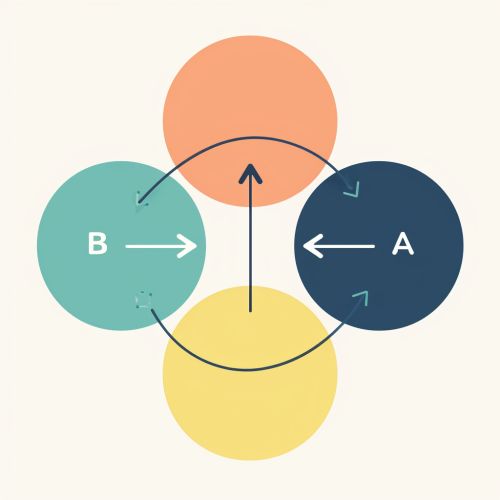Equivalence relation
Definition
An equivalence relation is a concept in set theory, a branch of mathematical logic, that formalizes the intuitive notion of equality. It is a binary relation that, for any elements a, b, and c in a set, satisfies three conditions: reflexivity, symmetry, and transitivity.
Reflexivity
In the context of equivalence relations, reflexivity is the property that every element is related to itself. Formally, a relation R on a set A is reflexive if, for every element a in A, a is related to a under R. In symbolic terms, this is expressed as ∀a(aRa), where ∀ denotes "for all" and R denotes the relation.
Symmetry
Symmetry, another property of equivalence relations, states that if an element a is related to an element b, then b is also related to a. In formal terms, a relation R on a set A is symmetric if, for all a and b in A, if a is related to b under R, then b is related to a under R. Symbolically, this is written as ∀a∀b(aRb ⇒ bRa), where ⇒ denotes "implies".
Transitivity
The third property of equivalence relations, transitivity, holds that if a is related to b and b is related to c, then a is also related to c. Formally, a relation R on a set A is transitive if, for all a, b, and c in A, if a is related to b under R and b is related to c under R, then a is related to c under R. This is symbolically represented as ∀a∀b∀c((aRb ∧ bRc) ⇒ aRc), where ∧ denotes "and".


Examples of Equivalence Relations
There are many examples of equivalence relations in mathematics and other fields. For instance, the relation "is equal to" on the set of real numbers is an equivalence relation, as it satisfies reflexivity (every real number is equal to itself), symmetry (if a is equal to b, then b is equal to a), and transitivity (if a is equal to b and b is equal to c, then a is equal to c).
Another example is the relation "is congruent to modulo n" on the set of integers, where n is a fixed integer. This relation is reflexive (every integer is congruent to itself modulo n), symmetric (if a is congruent to b modulo n, then b is congruent to a modulo n), and transitive (if a is congruent to b modulo n and b is congruent to c modulo n, then a is congruent to c modulo n).
Equivalence Classes
Given an equivalence relation R on a set A, the equivalence class of an element a in A, denoted [a], is the set of all elements in A that are related to a under R. The set of all equivalence classes for a given equivalence relation is called the quotient set, denoted A/R.
Equivalence classes have several important properties. For instance, two equivalence classes are either identical or disjoint, meaning that they either contain exactly the same elements or no elements in common. This property is a direct consequence of the definition of an equivalence relation.
Applications of Equivalence Relations
Equivalence relations have many applications in various fields of study. In mathematics, they are used in areas such as algebra, number theory, and topology. For example, in algebra, the concept of an equivalence relation is fundamental to the definition of a group quotient. In number theory, equivalence relations are used to define congruence classes. In topology, they are used to define quotient spaces.
In computer science, equivalence relations are used in the study of data types and algorithms. For example, in the design of data structures, equivalence classes can be used to represent sets of objects that are equivalent in some sense.
In philosophy, equivalence relations are used in the study of identity and equality. For example, in the philosophy of language, the concept of an equivalence relation is used to analyze the semantics of identity statements.
